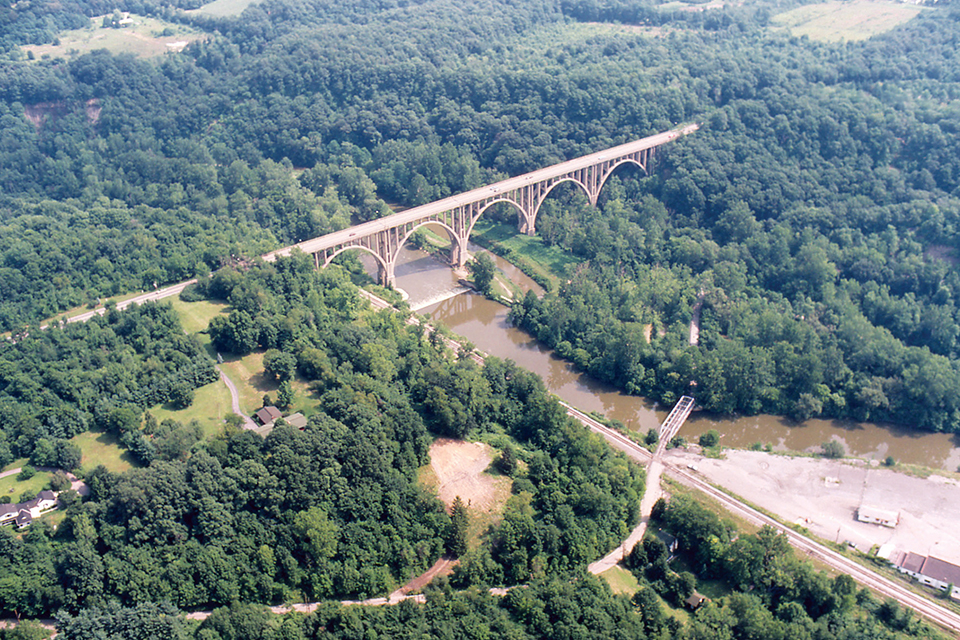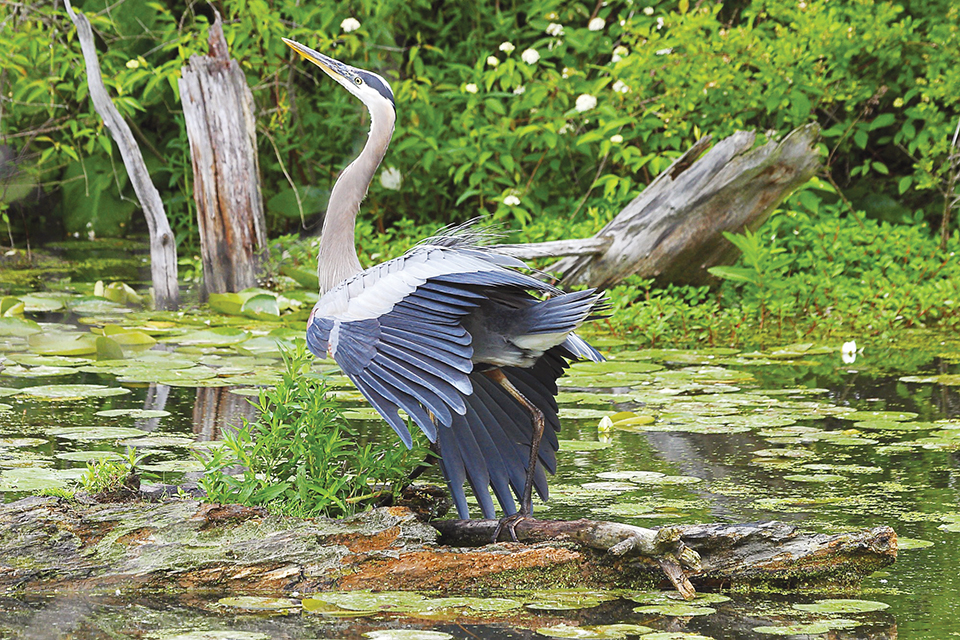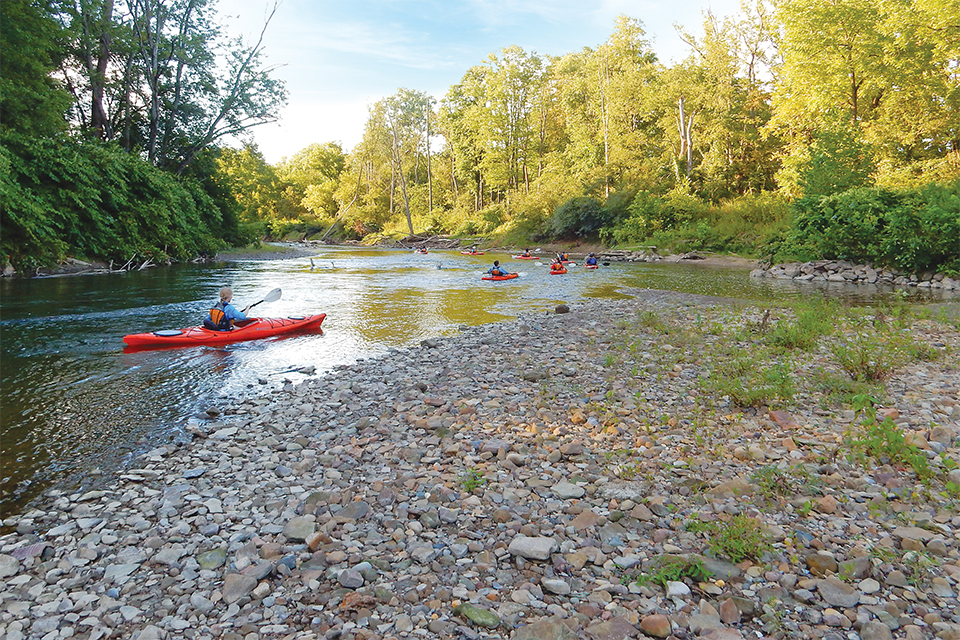Ohio’s National Park: How the Cuyahoga Valley Was Saved
In 1974, the federal government protected a serene stretch of nature now known as Cuyahoga Valley National Park. It was part of a movement to bring parks to people and set in motion work that continues today.
June 2024
BY Vince Guerrieri | Beaver Marsh, photo by iStock / PapaBear
June 2024
BY Vince Guerrieri | Beaver Marsh, photo by iStock / PapaBear
In the spring of 1974, U.S. Rep. John F. Seiberling appeared before the House Subcommittee on National Parks and Recreation to make an impassioned argument for the preservation of a portion of the Cuyahoga River Valley, and he knew time was not on his side.
Seiberling, a member of the family that founded Goodyear Tire & Rubber Co. and a Democrat first elected to Congress in 1970, represented a Summit County district that was still largely rural but was also quickly being reshaped by the rise of commercial centers and suburban sprawl. As Seiberling addressed the Congressional hearing on March 1, 1974, construction was already underway for a new sports arena in Richfield, with Cleveland Cavaliers owner Nick Mileti seeing the area’s potential for growth. The Richfield Coliseum opened several months later with Frank Sinatra taking the stage.
Despite the progress heralded by such a project, Seiberling hoped to illustrate how much stood to be lost. For untold generations, the Cuyahoga River and the land in the valley it runs through had been a vital natural resource. Indigenous people relied on the river for drinking water and crop irrigation.
As time went on, the river became vital to economic development, first as canals opened the interior of the state to trade and later as the rise of industry saw factories being built along the banks of the river. By the latter half of the 20th century, Seiberling feared that the valley’s identity as a place of natural beauty was in danger of being decimated.

A view of the Cuyahoga Valley from the 1970s, around the time the federal government set aside the land as Cuyahoga Valley National Recreation Area (photo courtesy of NPS Collection)
“With its magnificent cliffs and woods, waterfalls and meadows, it is a pastoral wonder, a quiet haven away from the nearby bustling cities,” Seiberling said in the statement he presented to the House subcommittee. “It is also a historic treasure, a reminder of our cultural roots and the earth which brought us forth. Truly it is an experience that must be saved, and shared, for future generations.”
The idea was met with resistance from some local officials who were unhappy about a park taking land off the tax rolls, but Congress passed the bill creating what was to be called the Cuyahoga Valley National Recreation Area — 32,000 acres along 22 miles of the Cuyahoga River — in December 1974. Despite his own objections, President Gerald Ford signed the bill into law just before the end of the year.
That foresight forever changed the trajectory of Summit County by creating what is today its most notable and accessible natural attraction. In 2000, Republican Congressman Ralph Regula, who had been instrumental in the original effort to garner federal protection for the land, shepherded through a name change for Cuyahoga Valley National Recreation Area.
The newly christened Cuyahoga Valley National Park was now in the company of destinations like Yosemite and Yellowstone, some of the first places in the United States set aside for the enjoyment of all. It was also the start of a new story about what the land contained within Ohio’s only national park can and should be.
***
Artifacts found in the Cuyahoga Valley indicate that humans were living there not long after the glaciers that carved out the Great Lakes receded around 10,000 years ago. Over the generations, these Indigenous people advanced from nomadic hunter-gatherers to farmers who used water from the Cuyahoga River to irrigate their crops.
“The Cuyahoga is one of the biggest riversheds in northern Ohio,” says Brian Redmond, an archaeologist and emeritus curator of archaeology at the Cleveland Museum of Natural History. “It’s a flood plain, and flood-plain soils are really rich for agriculture.”
Around 1650, Redmond says, Indigenous people began moving out, and in the 1700s, other Native American tribes such as the Wyandot and Ottawa moved in. The valley containing the Cuyahoga River ultimately became part of the Northwest Territory for the new United States and, in 1803, part of Ohio.
Seven years later, Johnathan Hale, a brickmaker from Connecticut, bought 500 acres of land sight unseen from the Connecticut Land Co., which had sold many spots throughout the valley as part of the Connecticut Western Reserve. That property remained in the Hale family until 1956 when it was bequeathed to the Western Reserve Historical Society, which today operates Hale Farm & Village there. Contained entirely within the boundaries of Cuyahoga Valley National Park, the living-history destination includes eight historic structures built by the Hale family and another two dozen moved to the property in order to preserve them.

The Cuyahoga River Valley has long been a place of recreation for northeast Ohio city dwellers. Men and women fish near Pinery Dam on the Cuyahoga River in 1895. (photo courtesy of NPS Collection)
In 1825, the same year the Erie Canal opened in New York as a connector between the Atlantic Ocean and the Great Lakes, the Ohio legislature authorized the construction of the Ohio & Erie Canal, linking the Ohio River in Portsmouth to Lake Erie. Traveling 308 miles, it ran through the middle of what is now Cuyahoga Valley National Park. Visitors can learn about that era at the Canal Exploration Center in Valley View. Those who want to explore the historic route on foot or by bicycle can do so on the Ohio & Erie Canal Towpath Trail that stretches nearly 100 miles from downtown Cleveland and traverses the length of the national park before continuing to its current end point in Dover.
By the 1880s, the railroads that were diminishing the canal’s role began offering excursion trips for urban residents to come out and enjoy the natural beauty of the Cuyahoga River Valley, connecting city dwellers with the outdoors. (The Cuyahoga Valley Scenic Railroad offers similar sightseeing excursions today.)
African Americans who moved north to work in the region’s mills and warehouses in the early to mid-20th century enjoyed evenings out at the Drift Inn/Cabin Club, Stonibrook and Lake Glen, all of which operated in the Cuyahoga Valley.
When the Cleveland Orchestra needed a summer home in the 1960s, it built an amphitheater not far from Riverview Road that was completed in 1967. Today, Blossom Music Center is contained within Cuyahoga Valley National Park and still hosts the orchestra’s summer series as well as a slate of nationally touring musical acts.
***
Taking in the stillness of Beaver Marsh or the roar of Brandywine Falls on a summer morning, it is still tough to imagine that a place like Cuyahoga Valley National Park exists in the shadow of two cities known for tires and steel more than peace and quiet.
Wildlife abounds here, from the beavers that have found a new home in a marsh that was once the site of a salvage yard to the great blue herons that build their enormous nests in treetops along Ira Road to the turtles that sun themselves on logs in pools of water that collect along the route of the Ohio & Erie Canal.
Since the Cuyahoga Valley received its designation as a national park in 2000, an ever-increasing number of travelers have found their way to it, many on a quest to visit the 63 national parks that dot the United States from the coast of Maine to the mountains of Alaska. But the true impact of Cuyahoga Valley National Park and where it still holds more promise to be realized is with those who live closest to its now approximately 33,000 acres.
“It’s been remarkable to me to watch the evolution of the community and the visitors and how much they appreciate this place,” says Lisa Petit, who has been with the park since 2000 and was named superintendent of Cuyahoga Valley National Park in 2021. “We did not fit the mold of a national park. We were a different kind of park, and we still are.”

The great blue heron is one of the many animal species that thrive in the Cuyahoga Valley today. (photo © Jim Schmidt)
It was the region’s proximity to Akron and Cleveland that inspired its preservation in the first place. The effort was born as part of the Parks to People movement of the early 1970s, aimed at establishing parks in or near urban areas for people who might not be able to travel to the large national parks in America’s west. Federally protected recreation areas were also established in the New York metro area and in San Francisco.
Although the national park federal designation received in 2000 increased the visibility of the Cuyahoga Valley, there is still work to be done in making it a resource for all, according to Deb Yandala, CEO of the Conservancy for Cuyahoga Valley National Park. The organization is one of the largest groups of its kind for a national park, with a budget of $8 million, a membership of 4,000 and a staff of 100.
“Our visitation isn’t completely reflective of the region,” Yandala says. “The park is close to the city but doesn’t connect with urban residents as much as it should, and we’re working on that.”
The park remains a work in progress ecologically too. Today, the Cuyahoga River is touted as an environmental success story, but when Petit started at the park, things were different.
“We were Cuyahoga Valley National Park along the Cuyahoga River, and we did everything we could to discourage people from even touching the river,” Petit says.
These days, it’s not uncommon to see kayakers paddling on the river and efforts in recent years, including the removal of the Brecksville Diversion Dam near the Station Road Bridge, have been aimed at further returning the river to a more natural state.

The Cuyahoga River, once a waterway that was polluted and not fit for recreation, is now a place for paddlers. (photo by NPS / D.J. Reiser)
In 1985, the park purchased the Krejci Dump, a former auto yard that required a massive cleanup, which was completed in 2020. The park faces similar issues with the Brandywine Golf Course in Peninsula, which closed in 2018. The conservancy purchased the course in 2022, keeping it from potential redevelopment, and later formally sold most of the land to the park.
“Most every old golf course before the EPA existed used things that you don’t want in the soil,” Yandala says. “It’s quite a process. We’ve had many, many, many truckloads of soil taken away.”
The park and conservancy are now seeking input for the best use of the golf course property. Petit says that these projects also provide an opportunity to revisit the park’s mission after a half century of existence and bring it closer to the spirit of the 1970s movement that aided in it being set aside in the first place.
“We have a fairly big hurdle to jump still,” Petit says. “We were put here between Akron and Cleveland for a reason, and we still haven’t reached those inner cities, especially in Cleveland. … One of our primary goals is to make good on our promise. We’re a park to some people, but we need to be accessible to all people.”
Related Articles

Tom Schiff Shares the Story Behind ‘Civic Architecture Across America: Extraordinary Views’
Cincinnati-based photographer Thomas Schiff’s new book contains over 100 panoramic views of our nation’s most beautiful civic buildings. READ MORE >>

Backstory: The Mound Builders
We know little of the long-gone Ohio Adena and Hopewell. Yet their earthworks remain, silent testimony to the grandeur of their civilizations. READ MORE >>

Ohio Finds: Woven Coverlet
This item was made by Frederick E. Hesse in Logan, Ohio, in 1862. READ MORE >>



